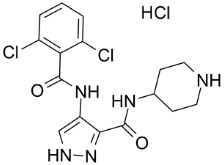All AbMole products are for research use only, cannot be used for human consumption.

AT7519 hydrochloride is a multi-CDK inhibitor for CDK1, 2, 4, 6 and 9 with IC50 of 10-210 nM. AT7519 displays potent cytotoxicity and apoptosis; associated with in vivo tumor growth inhibition and prolonged survival. At the molecular level, AT7519 inhibited RNA polymerase II (RNA pol II) phosphorylation, a CDK9, 7 substrate, associated with decreased RNA synthesis confirmed by [(3)H] Uridine incorporation. In addition, AT7519 inhibited glycogen synthase kinase 3beta (GSK-3beta) phosphorylation.
| Cell Experiment | |
|---|---|
| Cell lines | MM.1S, MM.1R, RPMI8226, U266, RPMI8266, RPMI-Dox40, OPM1 cells, primary MM cells and PBMNCs |
| Preparation method | Incubating cells with different concentrations of AT7519 for 24 or 48 hours at 37°C. Assaying cell viability by measuring 3-(4,5-dimethylthiazol-2-yl)-2,5 diphenyl tetrasodium bromide (MTT) dye absorbance. Measuring DNA synthesis by tritiated thymidine uptake (3H-TdR).Assessing Apoptosis by using Annexin V/PI staining. Defining the percentage of cells undergoing apoptosis as the sum of early apoptosis (Annexin V-positive cells) and late apoptosis (Annexin V-positive and PI-positive cells |
| Concentrations | Dissolved in DMSO at a concentration of 10 mM, final concentrations 0.25-4 μM |
| Incubation time | 24 or 48 hoursMale SCID mice inoculated subcutaneously with MM.1S cells |
| Animal Experiment | |
|---|---|
| Animal models | |
| Formulation | Dissolved in 0.9% saline |
| Dosages | 15 mg/kg/day |
| Administration | Dosed i.p. |
| Molecular Weight | 418.71 |
| Formula | C16H18Cl3N5O2 |
| CAS Number | 902135-91-5 |
| Solubility (25°C) | DMSO 50 mg/mL |
| Storage |
Powder -20°C 3 years ; 4°C 2 years In solvent -80°C 6 months ; -20°C 1 month |
| Related CDK Products |
|---|
| (E/Z)-Zotiraciclib citrate
(E/Z)-Zotiraciclib citrate is a potent CDK2, JAK2, and FLT3 inhibitor. |
| Abemaciclib metabolites M2
Abemaciclib metabolite M2 (LSN2839567) is a metabolite of Abemaciclib, acts as a potent CDK4 and CDK6 inhibitor, with IC50 values of 1.2 and 1.3 nM, respectively. |
| CDK9-IN-1
CDK9-IN-1 is a novel, selective CDK9 inhibitor, with an IC50 of 39 nM for CDK9/CycT1, it can be used for the research of HIV infection. |
| XO44
XO44 (PF-6808472) is a broad-spectrum covalent kinase probe. |
| ML 315
ML 315 is a selective dual inhibitor of CDK and DYRK with IC50s of 68 nM and 282 nM, respectively. |
All AbMole products are for research use only, cannot be used for human consumption or veterinary use. We do not provide products or services to individuals. Please comply with the intended use and do not use AbMole products for any other purpose.


Products are for research use only. Not for human use. We do not sell to patients.
© Copyright 2010-2024 AbMole BioScience. All Rights Reserved.
